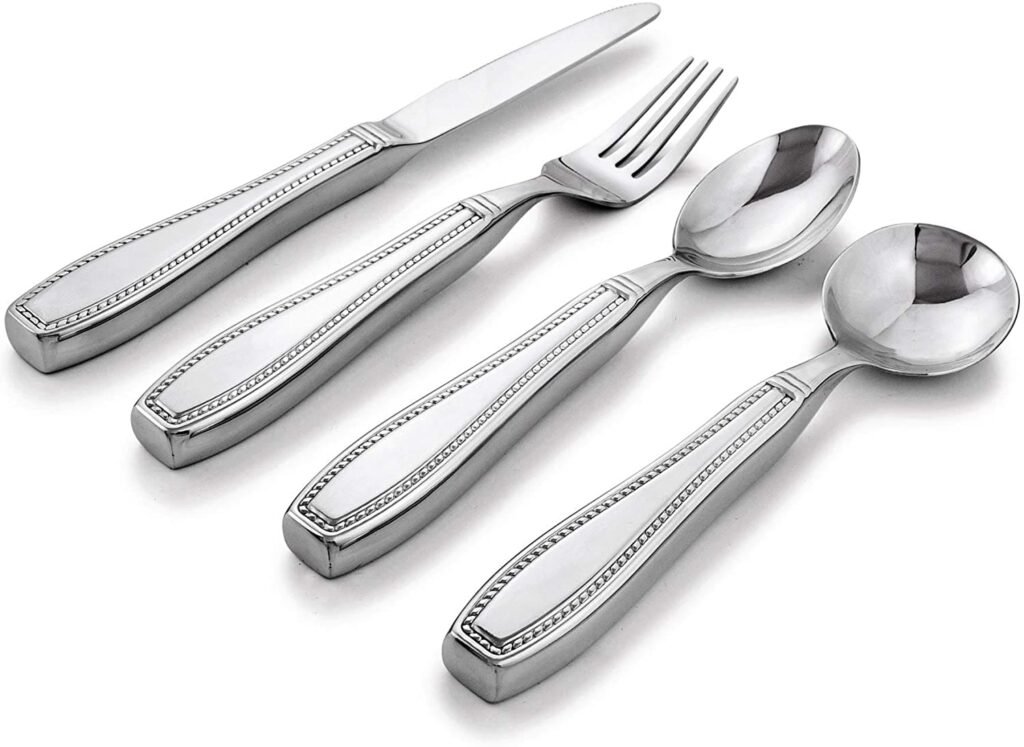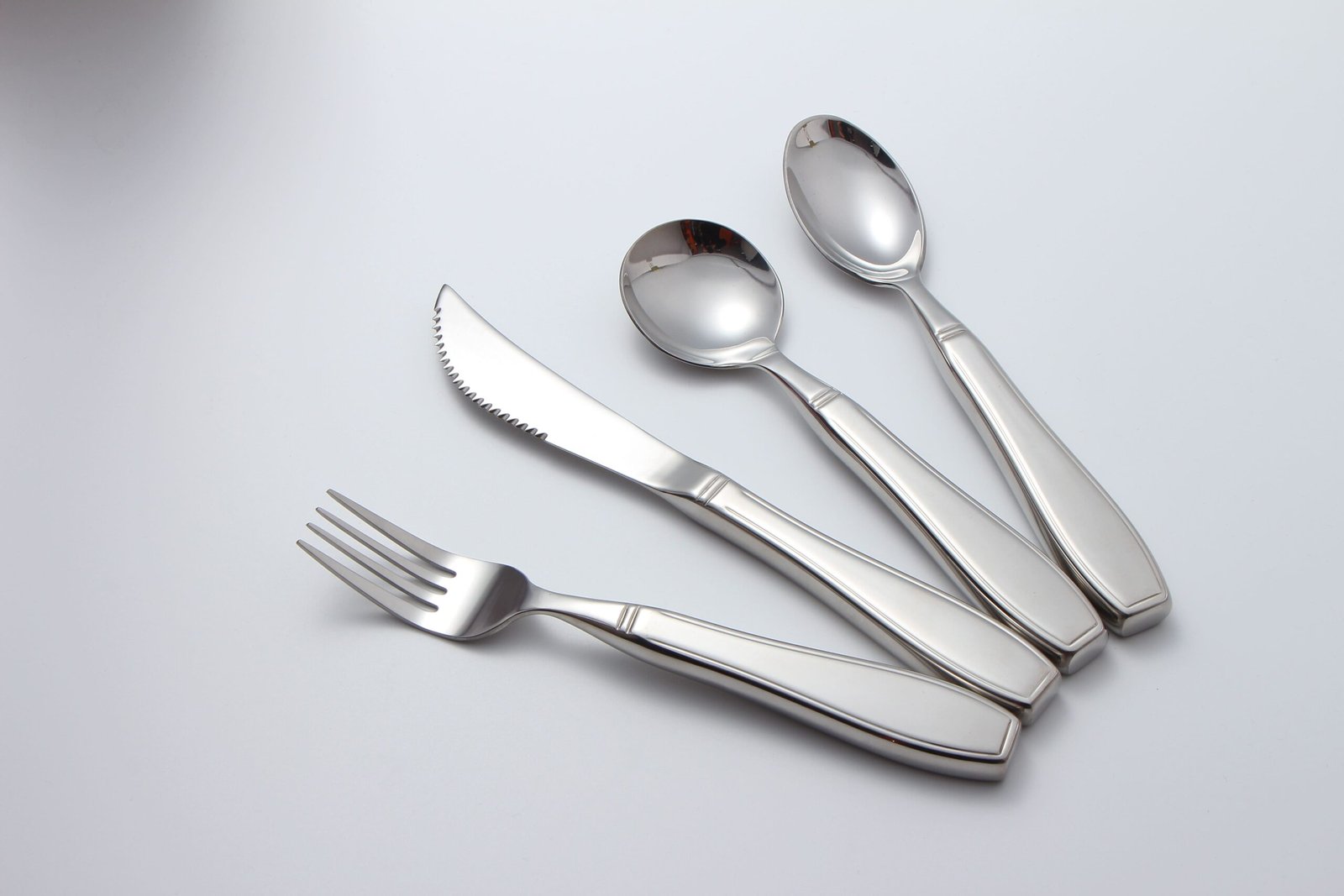Eating with Parkinson’s can be frustrating and exhausting, leading to poor nutrition and loss of independence.
Adaptive utensils designed for Parkinson’s patients help reduce tremors, improve grip, and make mealtime easier and safer.
Eating can be one of the hardest daily tasks for Parkinson’s patients. Adaptive utensils offer real help. Let’s explore what equipment works best and why.
Table of Contents
What is the adaptive equipment for eating with Parkinson's disease?
Living with Parkinson’s means struggling with shaking hands and slow movements, making eating difficult.
Adaptive eating equipment includes weighted utensils, ergonomic handles, and cups designed to stabilize and assist patients with Parkinson’s tremors and motor challenges.
Types of Adaptive Equipment
| Equipment Type | Purpose | Benefits |
|---|---|---|
| Weighted Utensils | Add weight to reduce hand tremors | Stabilizes hand movement, reduces spill risk |
| Ergonomic Handles | Enlarged or contoured grips for easy hold | Improves grip comfort and control |
| Non-slip Mats | Prevents dishes from sliding | Enhances meal safety and independence |
| Cups with Lids | Spill-proof drinking solutions | Reduces choking risk and minimizes mess |

Why Adaptation is Necessary
Parkinson’s causes hand tremors, rigidity, and slow movements. Normal utensils don’t support these challenges well. Adaptive tools reduce frustration and make meals more manageable.
Critique on Available Equipment
While adaptive utensils help, they aren’t perfect. Weighted utensils can be tiring for some users. Ergonomic designs vary, and not all patients find the same tools effective. Customization remains key.
What is the best equipment for Parkinson's patients?
Finding the best equipment depends on individual symptoms and needs.
The best equipment combines weighted utensils, easy-grip handles, and spill-resistant cups tailored to the user’s specific motor challenges.
Customization Matters
| Symptom | Recommended Equipment | Notes |
|---|---|---|
| Tremors | Weighted utensils, stabilizing gloves | Weighted tools help counterbalance shaking |
| Weak grip | Large-handled utensils, silicone grips | Larger grips and soft textures reduce hand strain |
| Poor coordination | Plate guards, no-tip cups | Help prevent spills, improve mealtime confidence |

Balancing Weight and Comfort
Heavier utensils help control tremors but can tire muscles. Some patients prefer lighter tools with non-slip grips. Testing different options is essential.
Combining Tools for Best Results
Often, combining weighted spoons with no-spill cups and plate guards gives the best overall independence during meals. A multi-tool approach helps cover different symptoms.
What cutlery is best for tremors?
Tremors cause uncontrolled shaking, making fine motor tasks hard.
Cutlery designed for tremors features extra weight and ergonomic grips to reduce hand movement and improve stability.
Weighted vs. Non-Weighted Cutlery
| Feature | Weighted Cutlery | Non-Weighted Cutlery |
|---|---|---|
| Weight | Heavier, adds stability | Lighter, easier to handle |
| Control | Reduces tremor impact | May increase spill risk |
| Fatigue | Can cause hand fatigue | Less tiring but less stable |
| Best For | Moderate to severe tremors | Mild tremors or general use |
| Common Materials | Stainless steel with added mass | Plastic, standard stainless steel |
Handle Design
Handles that are thick, curved, or rubber-coated help patients keep a firm grip. Smooth, thin handles often worsen tremors.
Material Considerations
Stainless steel is durable but may be slippery. Silicone-coated handles improve grip comfort. Some patients prefer plastic for lighter weight.
What types of adapted cutlery and cups are available to support a patient with Parkinson's during mealtimes?
Various adapted tools exist to meet the unique challenges Parkinson’s patients face during meals.
Adaptive cutlery includes weighted spoons, forks with large handles, and angled utensils, while cups come with lids, straws, or stabilizing bases.
Categories of Adapted Utensils
| Cutlery Type | Description | Best For |
|---|---|---|
| Weighted Utensils | Heavier tools to counter tremors | Patients with strong shaking |
| Angled Utensils | Bent handles for easier hand positioning | Limited wrist movement |
| Built-up Handles | Thick grips for better hold | Weak grip or arthritis |
| Swivel Utensils | Heads that rotate to stay level | Uncontrolled or jerky movements |
| Universal Cuffs | Straps utensils to the hand | No grip strength or coordination |

Adaptive Cups Varieties
| Cup Type | Features | Use Case |
|---|---|---|
| Spill-proof cups | Lids with small openings | Prevent spills |
| Weighted cups | Heavier base for stability | Reduce tipping |
| Cups with handles | Large, easy to hold handles | Improve grip |
| Nosey cups | Cut-out rim to avoid head tilt | For limited neck mobility |
| Insulated cups | Maintain beverage temperature | Hot or cold drinks over time |
Challenges in Finding the Right Fit
Not all patients respond equally to the same equipment. Trial and error help find the right combination. Some devices may be bulky or expensive, limiting use.
What utensils are used for tremors in Parkinson's patients?
Utensils for tremors focus on reducing hand shake impact.
Heavier, ergonomically designed utensils with wide handles are most commonly used to combat tremors in Parkinson’s patients.
Features That Help
| Feature | Benefit |
|---|---|
| Weight | Stabilizes hands against shaking |
| Handle Size | Easier grip, reduces fatigue and dropping |
| Material | Non-slip coatings improve grip and safety |
The Role of Technology
Some modern utensils include motion sensors and gyroscopic stabilization. These advanced tools can filter out tremors electronically but are costly.
Practical Considerations
Weighted utensils are widely accessible and cost-effective but may not suit everyone. Ergonomic fit is key to prevent fatigue and frustration.
What do people with Parkinson's struggle with in the kitchen?
Parkinson’s affects many skills needed for cooking and eating safely.
Common struggles include hand tremors, slow movements, poor coordination, and difficulty gripping utensils or opening containers.
Motor Symptoms Impacting Cooking
| Symptom | Effect on Kitchen Tasks |
|---|---|
| Tremors | Difficulty holding tools steadily, spills |
| Rigidity | Reduced flexibility, trouble with stirring or reaching |
| Bradykinesia | Slow movements, delays in chopping or cooking |
| Postural instability | Increased risk of spills, falls, or accidents |
Psychological and Safety Issues
Fear of spills or accidents can reduce confidence. This leads to avoidance of cooking and dependence on others.
Assistive Strategies
Using adaptive utensils, simplified recipes, and assistive devices can help maintain independence. Safety measures like non-slip mats and clear workspaces are important.

What are adaptive utensils?
Adaptive utensils are specially designed tools to help people with physical challenges eat independently.
They include weighted, ergonomic, or modified handles that compensate for tremors, weakness, or limited mobility.
Types and Design Principles
| Type | Design Feature | Purpose |
|---|---|---|
| Weighted Utensils | Added mass | Reduce tremor effect |
| Built-up Handles | Enlarged, contoured grips | Improve grip and control |
| Angled Utensils | Bent shafts | Reduce wrist strain |

Importance of Custom Fit
No single design fits all. Adaptive utensils must match the user’s hand size, strength, and tremor severity.
Market Trends and Innovations
Recent designs include electronic stabilization and smart utensils with sensors. These can greatly help but are not widely accessible yet.
After working in the cutlery industry for over 10 years, I have seen how crucial the right tools are for Parkinson’s patients. The challenge lies in balancing weight, grip, and comfort. It’s not just about adding weight to stop tremors; ergonomics and personal preference matter most. I recommend patients try various options and adjust as their condition changes. Innovations like gyroscopic utensils show promise but affordability is an issue. From my perspective as a designer and marketer, the future of adaptive cutlery should focus on modular, customizable solutions that evolve with the user’s needs. We must keep advocating for affordable, effective tools that restore dignity and independence at mealtimes.





